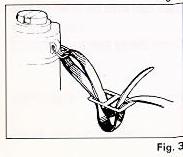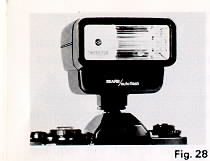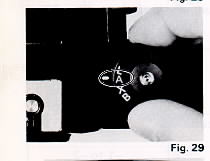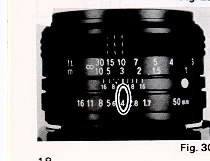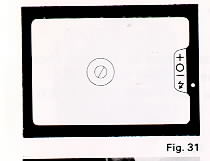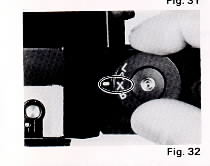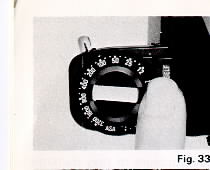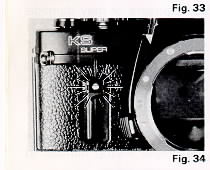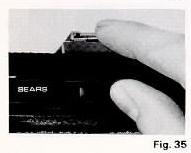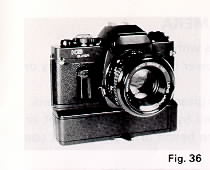SEARS KS Super
This camera manual library is for reference
and historical
purposes, all rights reserved.
This page is copyright
© by
 ,
M. Butkus, NJ.
,
M. Butkus, NJ.
This page may not be sold or distributed without
the expressed permission of the producer.
I have no connection with any camera company.;
Sears, USA;
Ricoh, Japan or any other camera manufacture.
On-line camera manual library
Back to main on-line
manual page
If you find this manual useful,
how about a donation of $3 to:
M. Butkus,
29 Lake Ave.,
High Bridge, NJ 08829-1701
and send your e-mail address
so
I can thank you.
Most other places would charge
you $7.50 for a electronic
copy
or $18.00 for a hard to read Xerox copy.
This will help
me to continue to host this site,
buy new manuals, and pay their shipping costs.
It'll make you feel better, won't it ?
If you use Pay Pal, use the link below.
Use the above address for a
check, M.O. or cash.
CLICK HERE FOR A
Sears KS Super
PDF VERSION OF THIS PAGE
CLICK HERE FOR A PDF MANUAL
MADE DIRECTLY FROM A MANUAL
Feb. 2010

CONGRATULATIONS
You have just purchased a fine camera that will give you many years of
picture-taking pleasure. The KS SUPER is a 35 mm SLR camera which assures you of
superb optics, outstanding mechanical performance and reliability which will
justify your choice for years to come.
Before using your KS SUPER.....
Please read this instruction booklet carefully and familiarize yourself with
the equipment and its features thoroughly. Your pleasure in using your KS SUPER
will be greater if you know your camera thoroughly.
1. NOMENCLATURE ...... 2
2. SPECIFICATIONS ...... 4
3. ATTACHING THE VIEWFINDER CAP AND STRAP ...... 6
4. CHANGING LENSES ...... 7
5. INSERTING THE BATTERIES ...... 8
6. INSERTING THE FILM ...... 9
7. SETTING THE FILM SPEED ...... 11
8. INDICATORS IN THE VIEWFINDER OF THE KS SUPER ...... 12
9. AUTOMATIC EXPOSURE PHOTOGRAPHY ...... 12
10. F-STOP NUMBER GUIDE ...... 14
1 1. HOLDING THE CAMERA ...... 14
12. FOCUSING ...... 15
13. REWINDING THE FILM ...... 16
14. EXPOSURE ADJUSTMENT SYSTEM ...... 17
15. FLASH PHOTOGRAPHY ...... 18
16. USING OTHER FLASH UNITS ...... 19
17. USING THE SELF-TIMER AND VIEWFINDER CAP ...... 20
18. USING THE AUTO WINDER ...... 21
19. DEPTH OF FIELD ...... 21
20. PROPER CARE OF YOUR CAMERA ...... 22
NOMENCLATURE
| 1. Shutter Speed Index Line
2. Shutter Release Button
3. Shutter Speed Dial
4. Film Advance Lever
5. Exposure Counter
6. Strap Eyelet
7. Self-Timer Indicator Light
8. Lens Release Lever
9. F-Stop Ring
10. Lens Mounting Locator Node |
11. Focusing Ring
12. Distance Scale
13. Depth of Field Scale
14. Flash Synchro Terminal
15. Self-Timer Button
16. Film Speed Indicator
17. Film Speed Dial
18. Film Rewind Knob
(Back Cover Opening Knob)
19. Film Rewind Crank
20. Exposure Compensation Dial |

| 21. Exposure Compensation Index Line
22. Hot Shoe
23. Dedicated Flash Signal Contact
24. Viewfinder Eyepiece
25. Film Rewind Shaft
26. Film Chamber
27. Battery Compartment Cover
28. Tripod Socket
29. Sprocket |
30. Film Take-up Spool
31. ASA/DIN Conversion Table
32. Back Cover
33. Film Pressure Plate
34. Winder Positioning Hole
35. Winder Coupler
36. Film Rewind Release Button
37. Winder Contact |
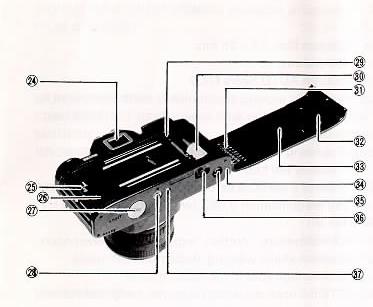
SPECIFICATIONS
TYPE ............35 mm SLR with focal plane shutter and automatic
electronic exposure control.
FILM FORMAT AND SIZE OF FRAME .........35 mm film- 24 x 36 mm
LENS MOUNT ............ "K" mount
STANDARD LENSES ..................... 50 mm AUTO Sears f/2.0
SHUTTER ............... Vertically moving electronically-controlled
metal focal plane shutter with speeds
from 1 to 1/500 sec. (auto), B.
X.
SELF TIMER ........................Operating delay of approx. 10 sees.
Operation indicated by red LED light.
VIEWFINDER ...................Field of view 90% vertically and
horizontally. Viewing magnification 0.88X
(with standard 50 mm f/1.4 lens)
INDICATIONS IN THE VIEWFINDER ................. Overexposure, correct
exposure, underexposure,
camera-shake warning, dedicated
flash ready.
FOCUSING ...............................Split-image spot in microprism
band
EXPOSURE METER ..................TTL full open metering for
center-weighted average light reading with
automatic exposure coupled to f
stops.
EXPOSURE COUPLING RANGE ................. EV 5 - 17 (ASA 100 film with
standard 50 mm f/1.4 lens)
FILM SPEED RANGE ............................... ASA 12 - 3200
FLASH TERMINAL .......................... X contact
ACCESSORY SHOE ........................ Hot shoe (with dedicated flash
ready signal contact) and flash synchro terminal.
EXPOSURE ADJUSTMENT ................... Exposure adjustment system (+2
to -2 in 1/3 steps)
FILM ADVANCE .............................. Single stroke film advance
lever with 135 degree winding angle (35degree stand-off)
Automatic advance
possible by mounting Sears, Auto winder #7356.
EXPOSURE COUNTER ................... Additive, automatic resetting
FILM REWIND ................................ By film rewind crank
system
MIRROR ................................ Quick return mirror
BACK COVER OPENING SYSTEM .............. Hinged cover, opened by
pulling up Film Rewind Knob.
POWER SOURCE ....................................... One CR-1 /3N 3V
Lithium battery This is one battery, as long as two of the
smaller batteries.
(Mallory-Duracell DL-1 /3N or equivalent)
(Two
SR-44 1.55V Silver Oxide batteries- Mallory
MS76,
Eveready S76 or equivalent, or two LR-44 Alkaline Manganese batteries
can also
be used on this camera.)
DIMENSIONS ................ 136(W) x 86(H) x 50(D) mm (Body only)
(5.4" x3.4" x 2.0")
WEIGHT (B0DY AND LENS) ................... 21.10 0z.
ATTACHING THE VIEWFINDER CAP AND STRAP
Viewfinder Cap For instructions on how to use the Viewfinder Cap, read the
section on Self-Timer Photography and Usage of the Viewfinder Cap. (Fig. 1 )
1. Slip the Viewfinder Cap on to the strap. (Fig. 2)
2. Put the Strap Eyelet and adjust it to the correct length. (Fig. 3)
CHANGING LENSES
To remove the lens from the camera.

|
Keep the Lens Release Lever pressed in, and turn the lens in
the direction of the arrow counterclockwise. (Fig. 4) |
To mount the lens on the camera
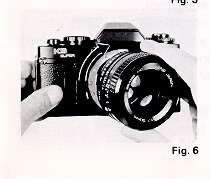
|
1. Line up the red dot on the lens mount with the matching red dot on the
camera body, or alternatively, match the red ( ~ ) mark on the Depth of Field
Scale to the red dot on the camera body. (Fig. 5)
2. When the lens has engaged, turn it in the direction of the arrow until it
clicks into place clockwise. (Fig. 6)
|
* For convenience when mounting the lens in the dark, you can line up the
Lens Locator Node with the Lens Release Lever.
* Since the body cap has the same mount as the lens. You can remove or mount
lens cap in the same way as the lens.
INSERTING THE BATTERIES
The exposure meter and shutter of this camera are powered by a battery, so it
is important to insert the battery correctly for proper operation.
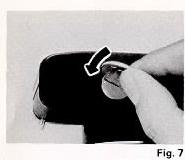
|
1. Remove the Battery Compartment Cover by turning it counterclockwise with a
coin. (Fig. 7)
2. Place the CR-1/3N Lithium battery (packed with the camera) as shown in the
illustration in the battery holder of the Battery Compartment Cover. (Fig. 8A)
|
Replacement Batteries
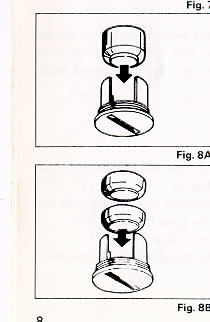 |
a) One Duracell DL-1 /3NB Lithium battery or equivalent;
life span about 12 months under normal use... OR
b) Two Duracell MS-76 Silver Oxide batteries or equivalent; life span about
12 months under normal use
(Fig. 8B)... OR
c) Two LR44 Alkaline batteries or equivalent; life span about 6 months under
normal use. (Fig. 8B) |
* Since dirt or skin oils may cause a bad contact, wipe the battery clean
with a dry cloth before inserting it.
* When your camera is not used for a long period of time, remove the
battery.
* Generally, in cold conditions, the voltage of the battery decreases and
this will impair the functioning of the shutter and
exposure meter. In these cases, either warm up the battery or keep a spare
set warm in your pocket ready to insert just before shooting.
* The camera will NOT operate if:
a) The battery is inserted incorrectly.
b) The battery is dead or low.
c) You failed to insert a battery.
If the camera does not operate, always check your
batteries.
INSERTING THE FILM
(Always avoid direct sunlight when inserting the film.)
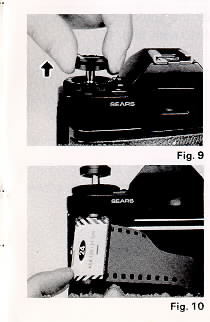 |
1. Pull up the Film Rewind Knob until the Back Cover snaps open. (Fig. 9)
2. Insert the film in the Film Chamber and push the Film Rewind Knob down to
its former position. (Fig. 10)
|
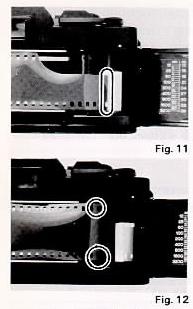 |
3. Insert the film leader into the slit on the Film Take-up Spool.
(Fig. 11 )
4. Advance the film, making sure that the sprocket holes on the film are
fully engaged on the
Sprocket Teeth. (Fig. 12)
|
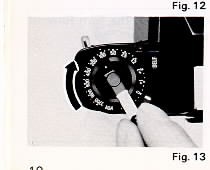 |
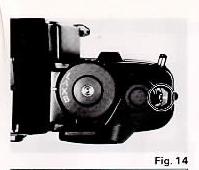 |
5. Close and press the Back Cover firmly to lock it. Unfold
the Film Rewind Crank and turn it gently in the direction of the arrow until
the slack in the film has been taken up. (Fig. 13) |
6. Advance the film and press the Shutter Release Button a few times until
the number "1" appears in the Exposure Counter. As you advance the Film Advance
Lever, the Film Rewind Knob rotates indicating that the film is properly
advancing. (Fig. 14)
* When advancing the film during film loading, it is more convenient to set
the Shutter Speed Dial to X to avoid a slow shutter release action. Remember to
set the Shutter Speed Dial back to A (Auto) after the film has been inserted.
* In cold conditions, the film leader may become hard and brittle. Warm the
leader in your hands before insertion.
SETTING THE FILM SPEED
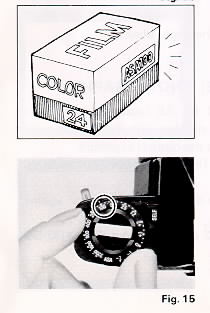
|
The film speed is the basic element for determining the exposure, so please
be sure to set the film speed correctly.
The film speed or ASA/DIN is listed on the film box.
1. Pull the Film Speed Indicator outer ring up, and set it against the film
speed number you are using. (Fig. 15)
For example, if the film speed is ASA 100, set the indicator on the Film
Speed Dial to 100. |
INDICATORS IN THE VIEWFINDER OF THE KS SUPER
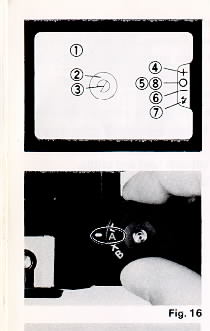
|
1. Matte Field
2. Microprism-image Band
3. Split-image Spot
4. Overexposure Indication
5. Correct Exposure Indication
6. Underexposure Indication
7. Dedicated Flash Ready Signal
8. Camera Shake Warning Light (When light blinks) |
AE (AUTOMATIC EXPOSURE) PHOTOGRAPHY
This camera is specially designed for AE (automatic exposure)
photography. Simply set the f-stop number, and the shutter speed is adjusted
automatically to give you the correct exposure.
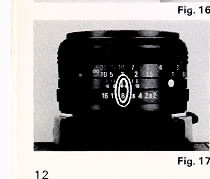
|
1. Set the A on the Shutter Speed Dial against the Shutter Speed Index Line.
(Fig. 16)
2. Move the F-Stop Ring to set the desired f-stop number against the central
index line. (Fig. 17)
(Generally F5.6 or 8 outdoors, F2 or 2.8 indoors ASA 1 DO/DIN 21 film)
|
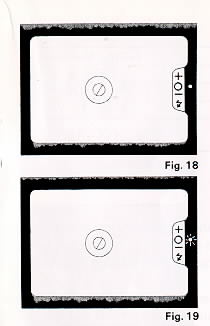
|
3. Look through the viewfinder and press the Shutter Release Button halfway.
If the exposure is correct, the green LED light on the right side of the (O)
lights up. (Fig. 18)
4. When the green LED light blinks on and off, it indicates camera shake
warning (a shutter speed of less than 1/50 sec.). If this happens, you should
select another f-stop number (a lower number).
If the green LED light still blinks after changing the f-stop number, use a
flash unit or tripod. (Fig. 19)
|
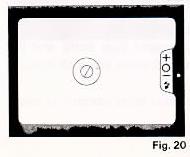
|
5. If the red LED light in the viewfinder lights up against
either the + or the - sign, the exposure is incorrect, and you should select
another f-stop until the green LED light lights up. If the red LED light
remains lit, such as in very dark conditions, use a flash unit. (Fig. 20) |
F-STOP NUMBER GUIDE
| Brightness |
F-Stop Number |
| Interiors |
f2 - 2.8 |
| Outside, cloudy conditions |
f4 - 5.6 |
| Outside, sunny conditions |
f8 -11 |
Beach in mid-summer end
snow scenes |
f11 - 16 |
* With Film Speed ASA 100
HOLDING THE CAMERA
Holding the camera correctly when shooting is very important.
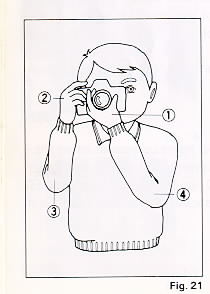
|
1. The camera should be positioned on the palm of your left hand so that you
can use your fingers to turn the Focusing Ring of the lens easily.
2. The index finger of your right hand should rest lightly on the Shutter
Release Button, while your right hand holds the camera body lightly.
3. Your right arm should be in a comfortable position.
4. Keep your left arm resting lightly against your body, and the camera
should just touch your forehead when you look through the viewfinder.
* It is important to shoot with the correct body posture, to avoid blurred or
tilted shots. |
FOCUSING
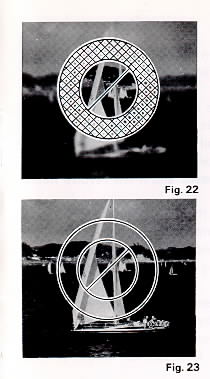
|
Look through the viewfinder to compose your picture and focus by turning the
Focusing Ring.
You can focus either by using the center Split-image Spot or the Microprism
Image Band that surrounds the center circle.
Split-image Focusing
When the split image in the Split-image Spot forms a single image, the
subject is in focus. (Fig. 22)
Microprism Focusing
When the subject loses its "shimmering" effect and becomes very sharp, the
subject is in focus. (Fig. 23)
|
REWINDING THE FILM
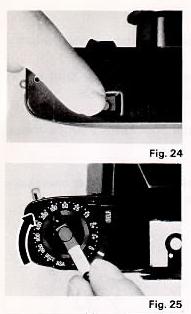
|
(Always avoid direct sunlight when unloading the film).
After the last picture on the roll of film has been taken, rewind the film.
1. Push-in the Film Rewind Release Button on the bottom of the camera, and it
will remain locked into position. (Fig. 24)
2. Unfold the Film Rewind Crank and turn it in the direction of the arrow.
When the film has been completely rewound, the tension of the Film Rewind Crank
is released and it will revolve freely.
(Fig. 25)
|
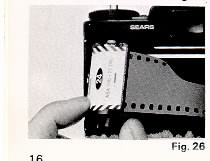
|
3. Pull up the Film Rewind Knob to its fullest extent and the Back Cover will
open. (Fig. 26) Remove the film, push the Film Rewind Knob back into position
and close the Back Cover.
* Never open the Back Cover during rewinding, as light will get in and ruin
your film.
* If you wind the film beyond the set number of frames, the Film Wind Lever
may get stuck midway and the Film Rewind Button cannot be locked in the down
position. If this should happen, I rewind the film by keeping the Film Rewind
Button pressed down with your finger.
|
EXPOSURE ADJUSTMENT SYSTEM
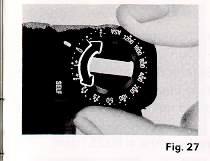
|
According to shooting conditions, the camera may be affected
more by the background light than the light of the subject itself. This will
result in under (or over) exposed pictures. In these cases, you should use
the Exposure Adjustment system. You can also use the system when you wish to
create a deliberate effect of over (or under) exposure. 1. Turn the Film
Exposure Adjustment Dial to set the required number against the Exposure
Adjustment Index Line. (Fig. 27) |
| Subject |
Exposure
Adjustment |
Scenery with a lot of sky
Figure against the light |
+1 to +2 |
| Figure with a snow scape or seascape background |
+1 |
| Spot-lighted figure |
-1 to -2 |
* The Exposure Adjustment Dial can be set to click stop positions (1/3 steps)
between the numbers indicated. Be sure to set it back to the 0 position after
use.
FLASH PHOTOGRAPHY
The Sears # 8025 dedicated AUTO/Thyristor electronic flash is available for
use with this camera. When using this specially designed flash unit, you can
leave the Shutter Speed Dial setting on A (Auto). Also, when the flash unit is
fully charged, the red LED light in the viewfinder lights up, so that you do not
have to take your eye away from the viewfinder eyepiece.
(Note - This only occurs when you are using the # 8025 flash). Using the
specially designed flash unit.
(Webmaster) - A Ricoh brand flash may also operate in the same function.
1. Attach the flash unit to the Camera Hot Shoe. (Fig. 28)
2. Set the A (Auto) on the Shutter Speed Dial against the Index Line. (Fig.
29)
3. Set the f-stop to the correct exposure setting for the flash unit. (Fig.
30) For subject which can be taken by automatic flash photography, the flash
unit will automatically control the amount of light to give the correct
exposure.
4. Turn on the power source switch on the flash unit. When the flash unit is
fully charged, the red LED Flash Ready Signal in the viewfinder lights up, and
the Shutter Speed is automatically synchronized to 1/100 sec. (Fig. 31 )
5. Press the Shutter Release Button to take the picture.
* Refer to the instructions with the flash unit for
detailed operating instructions.
* Do not use "DEDICATED" flash units designed for
other brand cameras, as this will cause incorrect exposure
or may damage the camera's
circuitry.
Using flash units other than the Sears DEDICATED AUTO/ Thyristor (# 8025)
1. Set the Shutter Speed Dial to X. (Fig. 32)
* With automatic flash units, set the F-stop number
designated for automatic flash photography.
* The flash units have a convenient Quick Reference.
Exposure
2. Table which can be used to set the proper F-stop number at specific
distances.
* When using other flash units, please follow the
instructions for that flash unit.
* With a non-dedicated flash, the flash ready signal in
the viewfinder will not operate.
SELF-TIMER PHOTOGRAPHY AND USAGE OF THE VIEWFINDER CAP
The self-timer enables you to include yourself in your own photographs for
commemorative occasions etc.
1. After advancing the film, press the Self-Timer Button (Fig. 33).
2. The Self-Timer Indicator Light will pulsate, and about 10 seconds later,
the shutter will be released. (Fig. 34)
3. If you wish to cancel the self-timer once it has started operating, set
the Shutter Speed Dial to L or B.
* If the film has not been advance, the self-timer will not operate.
Viewfinder Cap
When using the self-timer with the A (Auto) setting, to prevent light from
entering the viewfinder eyepiece and causing incorrect exposure, use the
Viewfinder Cap attached to the strap to cover the viewfinder eyepiece. (Fig. 35)
USING THE AUTO WINDER(#7356)
If you attach the Sears Autowinder to this camera, the film can be advanced
automatically. You can also take continuous shots at up to 2 frames per second.
(Fig. 36)
* Before attaching the winder, wipe the contact points on both the camera and
the winder with a dry cloth.
(Webmaster - A Ricoh brand winder may also work with this camera.)
DEPTH OF FIELD
When you focus on a specific subject, distance in front of and be hind the
subject will be acceptably sharp in your picture.
This area is called the "Depth of field". You can judge the depth of field in
the following way.
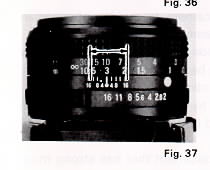
|
1. The Depth of Field Scale is indicated on each lens.
For instance when the camera-to-subject distance is 10 ft and 7 the
f-stop number is f16, the area within the two f/16 points on either side of
the "infinity" mark, will be in sharp focus (about 7 ft to 26 ft). (Fig. 37) |
PROPER CARE OF YOUR CAMERA
* Never touch the surface of the lens with your fingers.
* If the lens is dirty, either use a blower to blow the
dust away or wipe it gently with a soft cloth.
* Do not use chemically-treated eye glass tissue to clean
the lens.
* Camera malfunction can be caused by shock, humidity,
salt air etc. After using the camera at the beach
or in places that use chemicals,
wipe it carefully.
* Take care not to expose your camera to sudden changes in
temperature, as this may cause camera malfunction.
* Do not expose your camera for a long period of time in
extremely high temperatures, such as in the back
of your car or on a beach, as
this may cause camera malfunction.
* When using a tripod, do not try to force a long screw
into the socket.
(The screw length should be less
than 5.7 mm, JIS 5.5 mm).
* Do not place the camera near equipment that has strong
magnetism such as television or radio.
* Remove the battery before storing the camera, and keep
it in a place free of dust and humidity.
* Do not attempt to disassemble or repair your camera
yourself. If service is necessary, bring it to the nearest Sears store.




